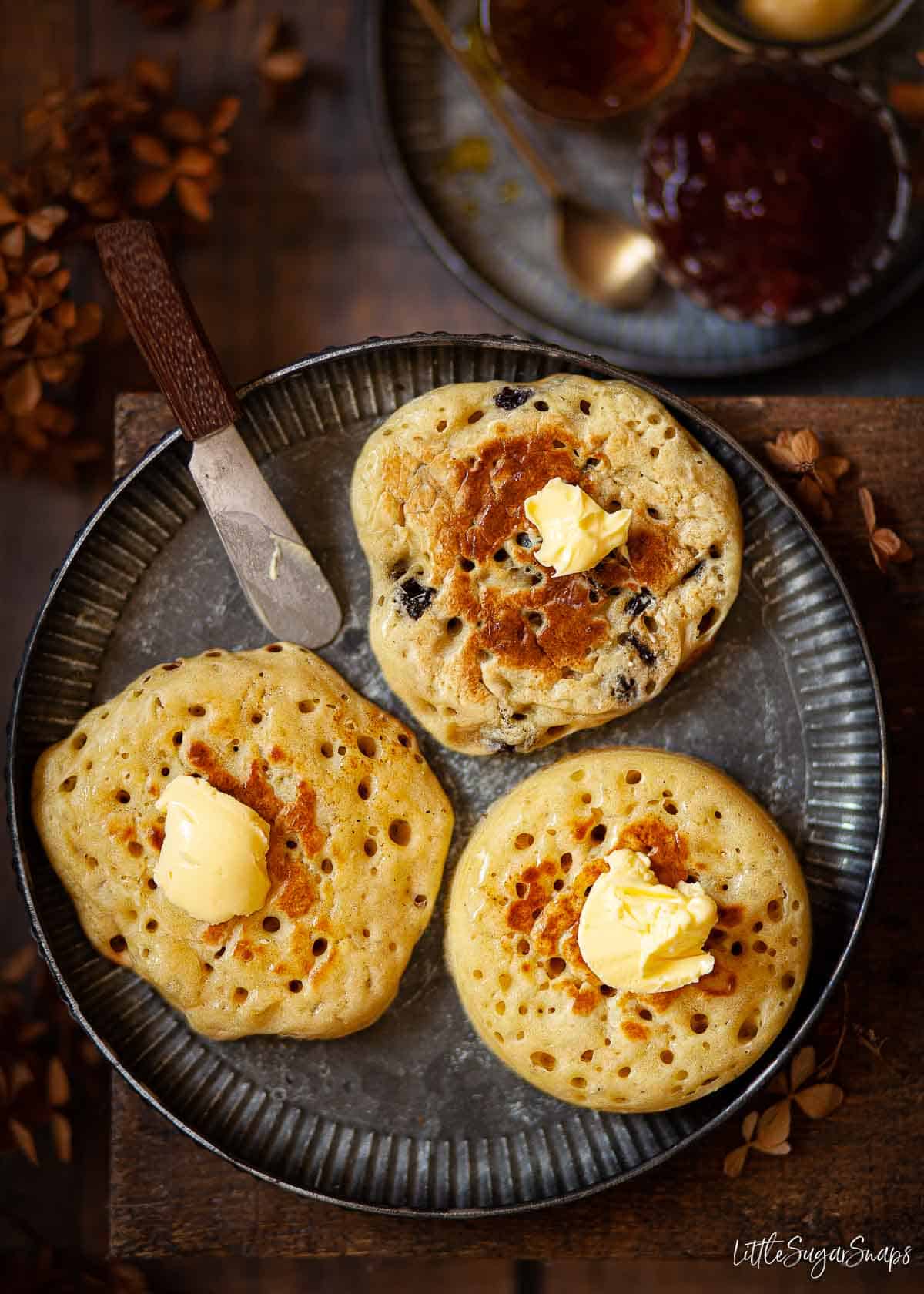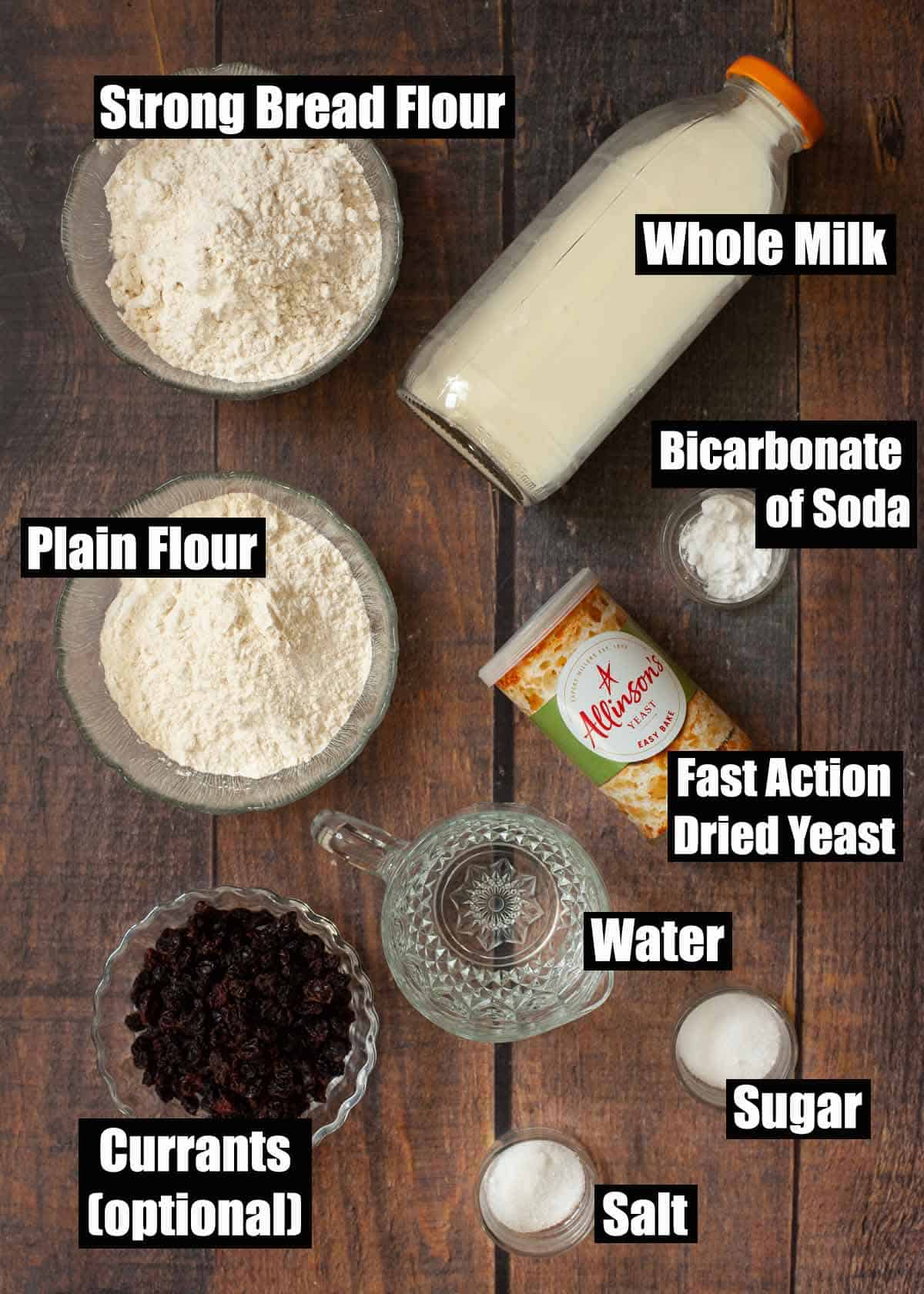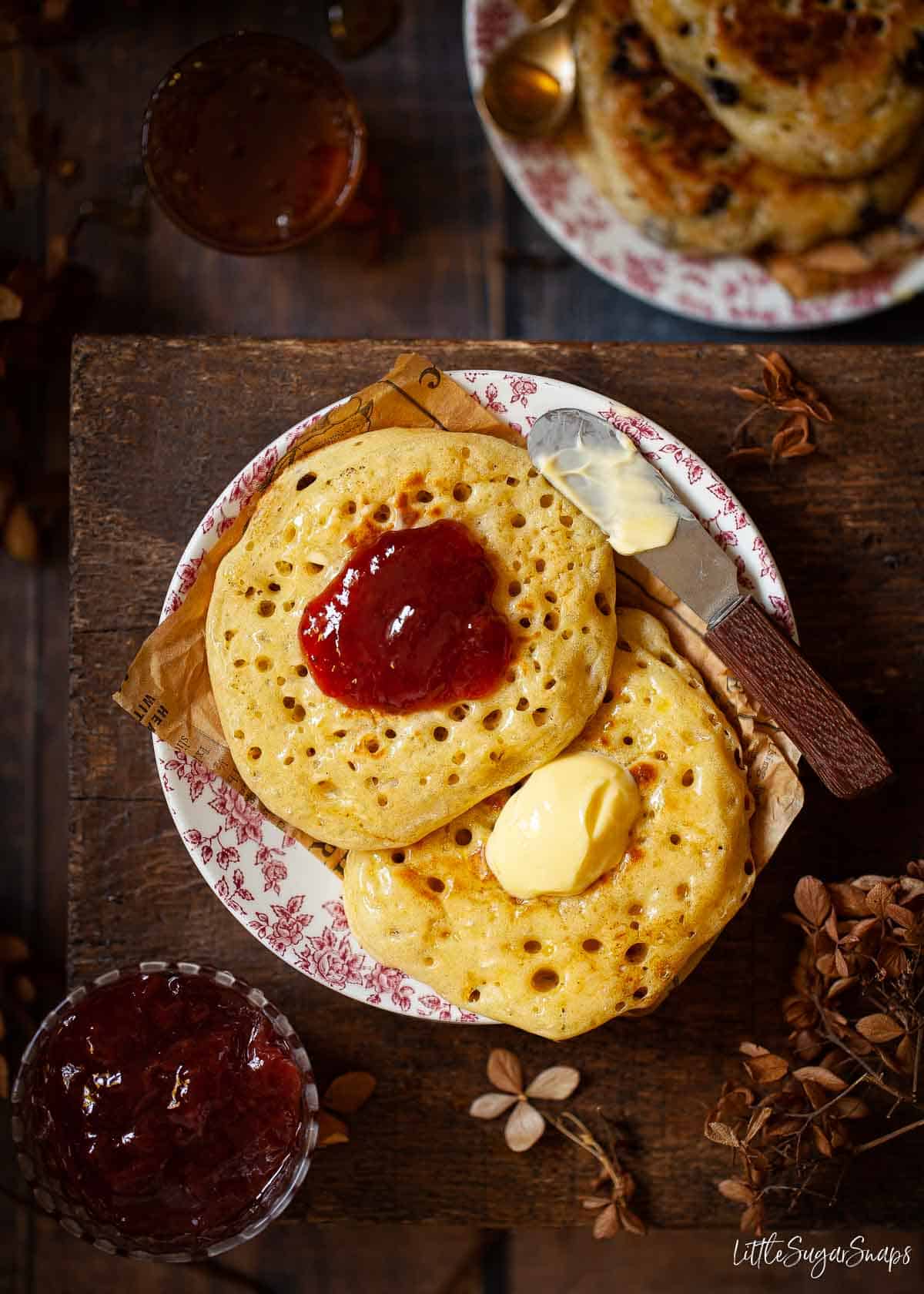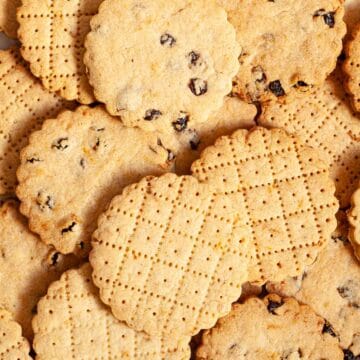English pikelets make a great snack or breakfast option especially when paired with butter, jam or golden syrup. This easy recipe for pikelets can be used to make crumpets and currants can be added to make fruit pikelets, which are popular in Staffordshire.
Don’t miss two more teatime treats Staffordshire oatcakes and Brummie bacon cakes.

Want to Save This Recipe?
Jump to:
English pikelets are wonderful treats traditionally served at teatime. They are characterised by their holey appearance and their slightly chewy, spongy texture. Pikelets are at their best when served warm, preferably toasted and slathered in copious amounts of butter.
This post is part of my collection of recipes from The Midlands. In what follows you’ll find out lots of juicy information about the origin of the pikelet and how this griddle bread differs from the crumpets that are commonplace in UK supermarkets.
But first, can I level with you? I’ve been hesitating to publish this recipe for pikelets because I know that the correct name of this delicious treat is hotly debated. A large proportion of the English population will argue, quite passionately, that they should, in fact, be called crumpets. So, I’ve dilly-dallied about pressing the publish button because I’m a little scared of being chased down by the food name police on social media, especially Constable Crumpet.
Gulp. I’ll just have to hope that PC Pikelet is ready to stand beside me.

Why you’ll love this recipe
- No fancy equipment is required – although it’s traditional to cook pikelets on a griddle pan a frying pan can be used instead.
- The batter makes plenty – expect around 12 (or 14 if you’re including currants).
- This recipe for pikelets can easily be doubled (or halved).
- They store well for several days and can even be frozen.
- Reheating these pikelets is simple – just pop them in the toaster until crisp.

What are pikelets?
English pikelets are griddle breads made from an unsweetened yeasted batter that is traditionally cooked on a griddle pan. They are typically around 8-10cm in diameter but as they are not cooked in a ring their shape and size vary.
As modern pikelet recipes usually include both yeast and bicarbonate of soda in the batter, as they cook holes appear on the surface. English pikelets have a chewy, springy, almost spongy texture and they act as great vessels for a variety of toppings.
Where do pikelets come from?
Pikelets are believed to have originated in Wales during Anglo-Saxon times, although they most likely resembled hard pancakes back then (yeast was not added to the batter until the Victorian era). Originally called bara pyglyd meaning pitchy (dark and sticky) bread, over time the name was shortened simply to pyglyd.
By the 17th century, word of this griddle bread spread to the West Midlands region of England when an English lexicographer (that’s a person who compiles dictionaries), spoke of Welsh barrapycleds. The name was anglicised first to picklets and then, finally, to pikelets.
The anglicised name took root and spread to Cheshire, Lancashire, Yorkshire, and other areas of the north. However, since West Midlanders were the first to adopt and rename these little Welsh griddle breads, I’m classing pikelets as a culinary treat from the West Midlands region. Exactly where in the West Midlands they first caught on is a bit of a mystery though.
What’s the difference between pikelets and crumpets?
In fact, is there a difference between a crumpet and pikelet? It’s a very good question, especially since the batter used is often identical and they have a lot in common:
- Pikelets and crumpets are both raised bread products made from a batter incorporating yeast and bicarbonate of soda.
- And both are traditionally cooked on a griddle.
- As they cook, holes (or pockets) appear on the top of both – perfect for melting butter to pool into.
But the difference between crumpets and pikelets comes down to how they are cooked:
- Crumpets are cooked in metal rings (crumpet rings). This keeps the batter in a neat circle as it cooks and allows a deep crumpet to be made (typically 1.5-2cm depth).
- Pikelets, however, do not use a cooking ring. Instead, the batter is spooned directly onto the pan freeform style, resulting in thinner griddle breads that are not uniform in shape.
So, it could be argued that pikelets are, in fact, flatter crumpets or crumpets made without a crumpet ring.
Note: I mentioned that crumpet batter and pikelet batter is often identical. I say often, rather than always, because, in my research for this recipe, I have come across several variations:
- Australian pikelets. These seem to be in line with drop scones, which are more pancake-like in style and do not contain yeast.
- I have also found just one English pikelet recipe that does not contain yeast.
- One recipe I found used buttermilk in the batter.
- And one recipe I found claims that West Midlands pikelets should be made with oatmeal.
As each of these alternative batters does not seem commonplace for a typical pikelet recipe in the UK, I’m giving a nod to them, but putting them aside.
Are pikelets the same as Staffordshire oatcakes?
Staffordshire oatcakes are not the same as pikelets. Oatcakes are rather like yeasted pancakes made from oatmeal batter. They are flat, typically around 20cm in diameter and intended for filling with savoury goodies such as bacon and cheese or for serving with a cooked breakfast rather than just slathering in butter and scoffing greedily (just me?).
It’s quite possible that the notion of creating smaller versions of the oatcake is what lead to the recipe I found for the oatmeal version mentioned previously.
Interestingly, I did stumble upon a recipe for Staffordshire pikelets, which contains currants. It sounded delightful, especially when there was mention of drizzling the fruit pikelets in Golden Syrup, so I have included details for this variation in my printable recipe card at the end of this post.
Are pikelets the same as drop scones?
No, they are not. There are a number of ways that drop scones (sometimes called Scotch pancakes) differ:
- Drop scone batter does not contain yeast.
- Instead, it relies on bicarbonate of soda (sometimes with a pinch of cream of tartar alongside) as a raising agent.
- The batter also contains egg whereas the recipe for pikelets is made without egg.
- Drop scones do not display the holey texture that characterises the pikelet.
Phew. Let’s get to the recipe!
Ingredients notes

Flour: I’ve used a blend of plain flour and strong bread flour. The reason for this is that although using just bread flour would help to create more rise from the yeast, it would also result in pikelets that are too chewy. (Let’s remember that bread dough is generally kneaded to relax the gluten). To avoid pikelets that are too chewy I’ve opted to include plain flour too.
Please do not use self-raising flour as it contains baking powder which is not required in this recipe.
Liquids: both milk and water are used to create the batter. Although using just milk would add to the flavour, it can result in a heavy batter. Using equal amounts of milk and water is the better way to take things.
Yeast: I’ve gone down the route of using fast-action dried yeast because it’s convenient and always gives great results. Feel free to use fresh yeast if preferred.
Salt & sugar: a little of each is included in this recipe. The white sugar helps the yeast to activate but as such a small quantity is used, it does not sweeten the batter. The salt adds flavour – leave it out at your own peril.
Bicarbonate of soda: also known as baking soda, this is added right before the batter is cooked to help those bubbles form, creating the lovely signature craters so useful for collecting melted butter or golden syrup.
Currants: these are optional and only required if you intend to make Staffordshire fruit pikelets.
Step by step instructions
Full instructions and measurements are given in the printable recipe card at the end of this post.
- Mix the milk and water together and heat to lukewarm.
- Put the flour, sugar and yeast into a large mixing bowl and add around ¼ of the liquid.
- Use a balloon whisk to mix the ingredients together, gradually adding the rest of the liquid. Stir until smooth.
- Cover and leave for 1-2 hours until bubbly.
- Add the salt and bicarbonate of soda (sieve it in). Mix in, then stir through the currants (if using).
- Grease your griddle pan (or frying pan) very lightly with butter and place it over medium-high heat.
- When it’s hot spoon around 1.5 tablespoons of batter into the pan, spreading it slightly with the back of a spoon. Repeat to allow yourself to cook 3 or 4 pikelets at a time depending on the size of your pan.
- Let them cook without turning them over, until the batter dries up. You might want to burst the bubbles that form using a cocktail stick.
- Once the batter looks dry on the top carefully flip the pikelets over and cook for 1-2 minutes until golden before removing them from the pan.
- Repeat steps 6-9 until all of the batter is used up.

Expert tips
Top Tip: Salt inhibits the activation of the yeast, so it is important not to add it into the batter until you are ready to begin cooking.
- Baking soda must not be added until the point of cooking because it activates immediately. If left to sit around in the batter the baking soda will lose its effectiveness and your pikelets will have less holes.
- Test the heat of the pan by cooking just one pikelet to begin with. The pikelets will need to be cooked for around 4-5 minutes before the batter dries out and they are ready to be flipped over. If the bottom of the pikelet burns as it cooks undisturbed then the heat is too high and needs to be lowered slightly before more are cooked.
- Keep the cooked pikelets warm by placing them on a warmed plate and covering lightly with foil before putting them into a warm (not hot) oven.
- Make crumpets instead Butter your crumpet rings and spoon around 3 tablespoons of the batter into each ring (it should be around halfway up). Cook, undisturbed, until the batter is dry on the top (again, you can pop the bubbles if you want to). When the batter is dry carefully remove the rings and turn the crumpets over then cook then for a further 1-2 minutes until golden. The recipe listed will make approximately 6 crumpets.
Frequently asked questions
Yes, you can. Mix the batter, cover and store it in the fridge for up to 24 hours. Let the batter sit at room temperature for 2 hours before adding in the bicarbonate of soda and salt, then proceed to cook.
Yes, they can. Transfer them straight from the freezer to the toaster and cook on medium heat for around 3 minutes until crisp and warmed through.
On their own, pikelets are not unhealthy. However, the toppings usually are. Butter is high in fat and jam & syrups are high in sugar.

Serving suggestions
If you’re looking for ideas on when or how to serve pikelets or what to put on them, I’ve got you covered with the following suggestions:
- Pikelets were traditionally eaten as an afternoon snack.
- But these days they are a common breakfast option too.
- Pikelets should always be served warm. Try them straight from the griddle for a soft and chewy option.
- To reheat cold pikelets, or to crisp up freshly cooked ones, give them a few minutes in the toaster.
- Butter is a crowd-pleasing and hugely satisfying topping for pikelets. Just smother a generous amount of butter onto the top, allow it to melt and tuck in. Expect the butter to run down your chin.
- Alternatively spread your favourite jam, marmalade or curd onto them.
- If you’re making Staffordshire pikelets with currants opt for a good glug of golden syrup.
- Go fancy and drizzle some honey or maple syrup over them.
- Or embrace your inner child and top with chocolate spread or Biscoff spread.
- You could even top them with cheese and slide them under the grill to melt it.
Have you made this recipe for pikelets? I hope you enjoyed it. Why not let me know how you got along by leaving a comment or rating below. You can also show me how you topped yours on Instagram by tagging me @jane_littlesugarsnaps.
New here? Why not sign up to receive LittleSugarSnaps newsletters. You’ll hear first-hand when new recipes are published. You’re welcome to stay in touch on Facebook, Instagram and Pinterest too.
📖 Recipe
Want to Save This Recipe?

English Pikelets (and Fruit Pikelets)
Equipment
- 1 Griddle pan or frying pan
Ingredients
- 150 ml Whole milk (full-fat)
- 150 ml Water
- 125 g Strong bread flour
- 100 g Plain flour (all-purpose)
- 1 teaspoon Fast-action dried yeast
- 1 teaspoon Salt
- ½ teaspoon White sugar
- ½ teaspoon Bicarbonate of soda (baking soda (not baking powder))
- 90 g Currants (optional)
- A little butter – for greasing the pan
Instructions
- Mix the milk and water together and heat to lukewarm either in a saucepan or in the microwave.
- Put the flour, sugar and yeast into a large mixing bowl and add around ¼ of the liquid.
- Use a balloon whisk to mix the ingredients together, gradually adding the rest of the liquid. Stir until smooth.
- Cover and leave for 1-2 hours until bubbly. The exact time needed will depend how warm your kitchen is. Expect it to take a shorter length of time on hot days and longer on cooler days.
- Add the salt and bicarbonate of soda (sieve it in). Mix in, then stir through the currants (if using).
- Grease your griddle pan (or frying pan) very lightly with butter and place it over medium-high heat.
- When it's hot spoon around 1.5 tablespoons of batter into the pan, spreading it slightly with the back of a spoon. Repeat to allow yourself to cook 3 or 4 pikelets at a time depending on the size of your pan.
- Let the pikelets cook, without turning them over, until the batter dries up. You might want to burst the bubbles that form using a cocktail stick.
- Once the batter looks dry on the top carefully flip the pikelets over and cook for 1-2 minutes until golden before removing them from the pan.
- Repeat steps 6-9 until all of the batter is used up.
Notes
- Salt inhibits the activation of the yeast, so it is important not to add it into the batter until you are ready to begin cooking.
- Similarly, the baking soda must not be added until the point of cooking because it activates immediately. If left to sit around in the batter the baking soda will lose its effectiveness and your pikelets will have less holes.
- Test the heat of the pan by cooking just one pikelet to begin with. The pikelets will need to be cooked for around 4-5 minutes before the batter dries out and they are ready to be flipped over. If the bottom of the pikelet burns as it cooks undisturbed then the heat is too high and needs to be lowered slightly before more are cooked.
- Keep the cooked pikelets warm by placing them on a warmed plate and covering lightly with foil before putting them into a warm (not hot) oven.
- Make the batter in advance – once mixed cover and store it in the fridge for up to 24 hours. Let the batter sit at room temperature for 2 hours before adding in the bicarbonate of soda and salt, then proceed to cook.












Sally brown
My Yorkshire husband has always known and called crumpets. — Pikelets.
Jane Saunders
🙂 It’s seemingly a huge debate!